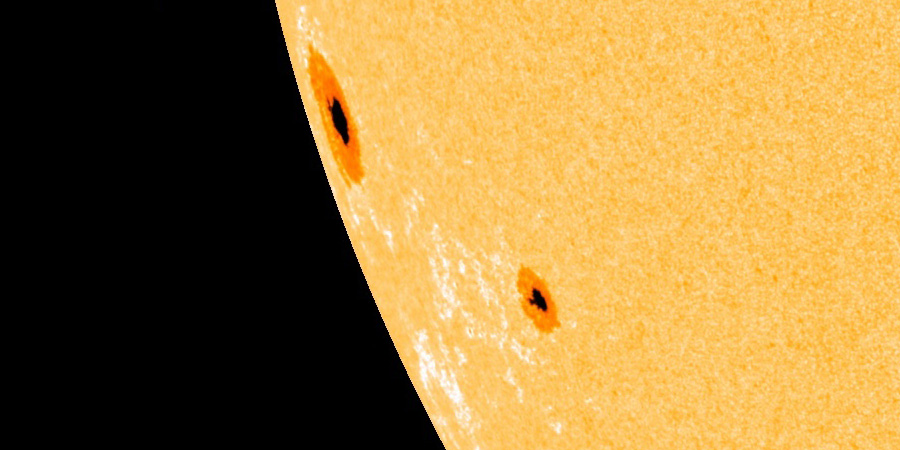Sunspot region 2785 and 2786
Monday, 23 November 2020 16:08 UTC

Two new sunspot regions have rotated into view on the south-east limb. These sunspot regions have received sunspot number 2785 and 2786. These sunspot regions were the source of a couple of far side eruptions over the past week and they looked very active while on the far side.
Sunspot region 2785 has now fully rotated into view and consists of just one sunspot at the time of writing. There seems to be a lot of faculae surrounding this sunspot which indicates this region had to be much larger on the far side but it looks like it decayed quite a bit before rotating onto the earth-facing side of the solar disk.
Sunspot region 2786 has only just starting to rotate onto the earth-facing disk so it is hard to say if there are more sunspots hiding behind the limb but there is at least one very large sunspot associated with this sunspot region. As said, there could be more sunspots hiding behind the limb but we will have to wait another 24 hours to know if there is more hiding behind the limb or if also this region only consists of one sunspot.
The X-ray background flux is around B3 at the moment which is not very high. This could indicate that these regions aren't as active anymore compared to when they were on the far side. Nonetheless interesting to see this steep increase in the solar activity less than 1 year after solar minimum. We will keep an eye on these sunspot regions in the days ahead to see if they perhaps develop more sunspots and cause a significant increase in solar activity. M-class activity is unlikely at the moment based on what we can see right now but these regions are well worth keeping an eye on the days ahead.
Thank you for reading this article! Did you have any trouble with the technical terms used in this article? Our help section is the place to be where you can find in-depth articles, a FAQ and a list with common abbreviations. Still puzzled? Just post on our forum where we will help you the best we can!
Latest news
Latest forum messages
Support SpaceWeatherLive.com!
A lot of people come to SpaceWeatherLive to follow the Sun's activity or if there is aurora to be seen, but with more traffic comes higher server costs. Consider a donation if you enjoy SpaceWeatherLive so we can keep the website online!

Space weather facts
| Last X-flare | 2025/03/28 | X1.1 |
| Last M-flare | 2025/03/31 | M1.2 |
| Last geomagnetic storm | 2025/03/27 | Kp5 (G1) |
| Spotless days | |
|---|---|
| Last spotless day | 2022/06/08 |
| Monthly mean Sunspot Number | |
|---|---|
| February 2025 | 154.6 +17.6 |
| March 2025 | 127 -27.6 |
| Last 30 days | 127 -25.7 |


